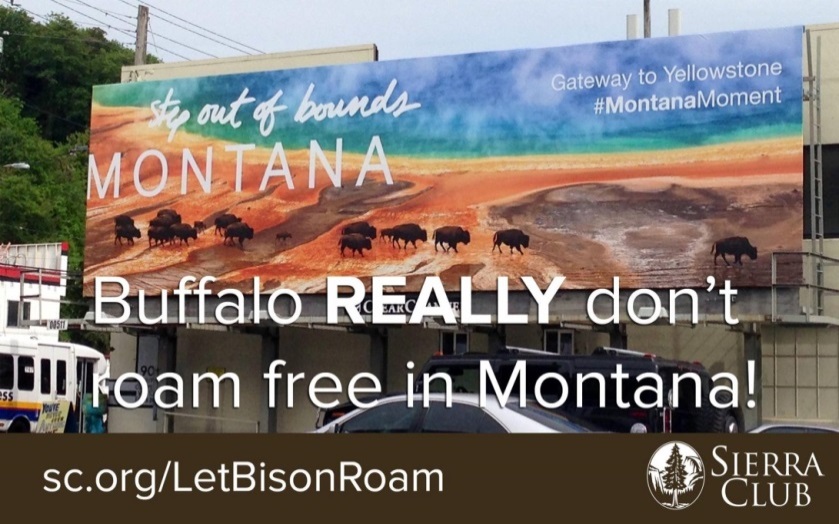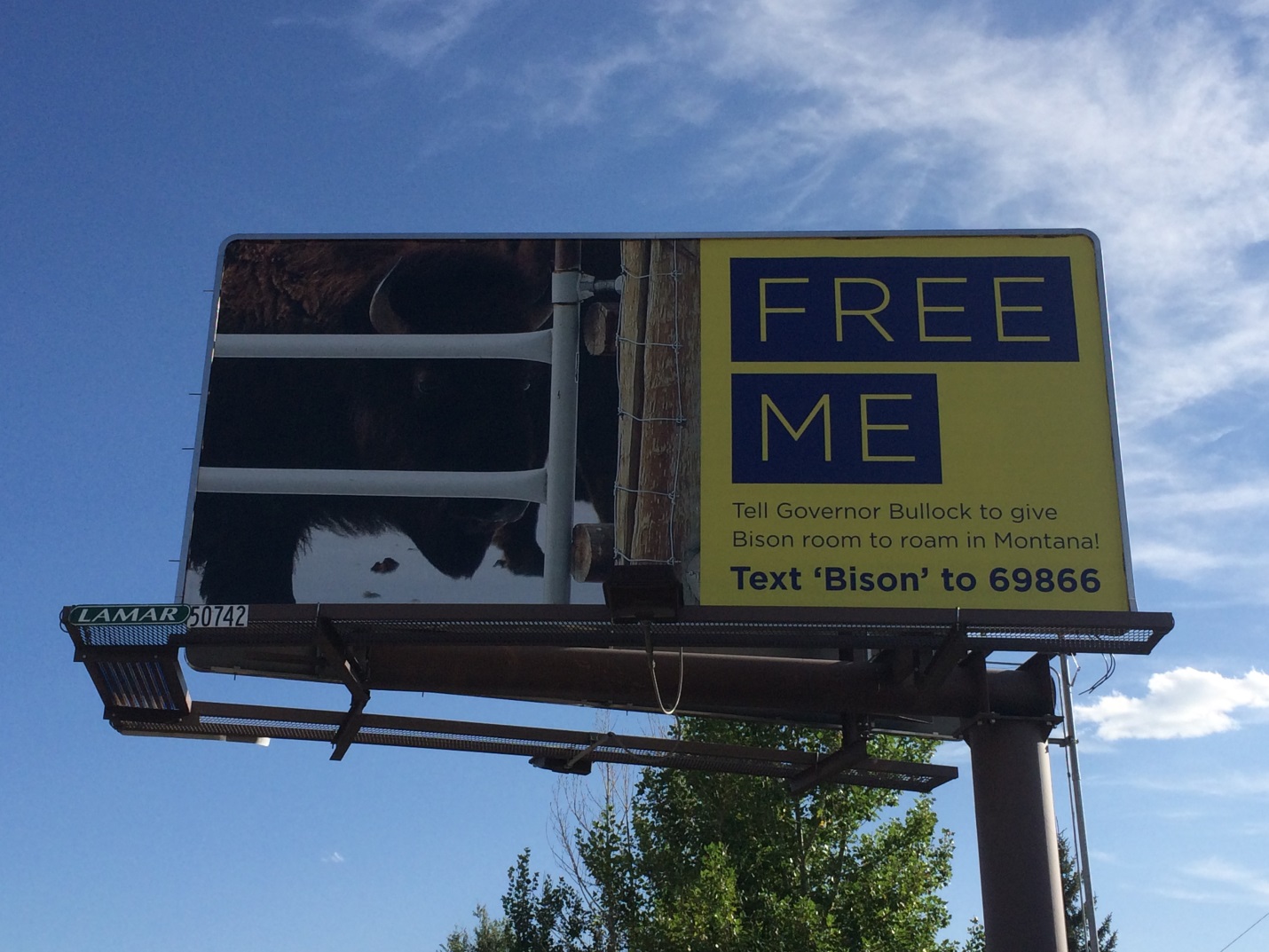In December 2015, Montana Governor Steve Bullock took a step forward in protecting the bison of Yellowstone National Park and the greater Montana plains. After years of activist organizing and public committee negotiations, hindered by departmental stalling and the two-steps-forward, one-step-back pattern that so often typifies government progress, American bison have been allocated 250,000 acres of year-round roaming space to the west of Yellowstone, plus 100,000 acres to the north for bulls.
The endeavor was a grueling one. For decades, Montana’s livestock industry has stood in firm opposition to the free roaming and expansion of bison herds. Bison compete with commercial cattle for the rich grasses of the Montana plains. Ranchers fear, too, the repercussions of the brucellosis contagion, to which around half of bison have been exposed; however, the disease’s communicability to livestock remains unverified.
According to Kiersten Iwai, a Sierra Club organizer in Bozeman, Montana, and a leading bison advocate, shifting public opinion was necessary for making headway. It was important to show ranchers that bison independence and their economic interests could coexist without infringing on one another too greatly.
Of course, bison have inhabited Montana whole geological eras longer than the livestock industry has. The unyielding slaughter of buffalo in the 19th century coincided with the decimation of native tribal lifestyles. Westward agricultural expansion wreaked habitat destruction and required settlers to kill off entire herds. Buffalo extermination also offered a tool for subjugating Indian tribes by choking off contact with a creature essential to their diets, economies, and spiritual practices. The sustainable relationship between bison and tribes was abruptly extinguished by U.S. government policies. At one point, Yellowstone’s bison population dwindled down to 25 members.
The bison’s size makes it majestic, commanding – even intimidating. But the larger the mammal, the more likely it is to reach maturity late in life, to gestate slowly, and to have only one offspring at a time. All of these biological traits make a species especially vulnerable to extinction at the hands of humans. This explains the mass extinction of wooly mammoths when Homo sapiens gained prominence as hunters worldwide, and the dire struggles today of elephants, rhino, and buffalo.
Bison stand as a keystone species, meaning they bolster the survival of other plants and animals in the area, in this case through their grazing patterns. Disappearance of bison spells trouble for the entire ecosystem. Conversely, a robust bison population helps protect the ecology of Yellowstone and beyond.
The debate is valuable for its biological and social overlay. In his book, The Battle for Yellowstone: Morality and the Sacred Roots of Environmental Conflict, sociologist Justin Farrell comments on the underlying moral implications of wildlife preservation. Coming to blows in the disagreement over bison are conflicting senses of entitlement to the land and natural resources. There is “tradition” in one sense, that of the native tribes, which were synchronized with bison for thousands of years before European arrival; and there is “tradition” in another sense, that of the ranchers in the area, whose families have owned and kept cattle on the same plots for generations.
The Sierra Club has taken a firm stand on the side of the tribes and the bison. Well-being of bison fits into the larger objective of protecting national parks. Potential for public involvement on the issue wasn’t fully realized until the National Resources Defense Council and the Stockgrowers Association came together, after the GAO reported authors of the Interagency Bison Management Plan weren’t adequately involving the public in deliberations. Out of this coalition grew the Bison Citizens Working Group in 2010, which included the state’s big businesses, tribes, and local residents. Zack Waterman represented the Sierra Club as the working group came up with comprehensive recommendations for the state’s Environmental Assessment.

A Sierra Club ad points out the hypocrisy of the state government using bison as a tourist draw while doing little in the way of conservation.
The course to a binding agreement was still rocky, but thanks to the efforts of the Montana chapter and allies, the bison campaign attracted huge attention. The Environmental Assessment received 115,000 public comments, an impressive feat in a state of only 1 million. Controversy between Montana’s Department of Livestock and the Department of Fish, Wildlife, and Parks produced an Addendum to the Environmental Assessment, which the governor’s office released in December 2014. Kiersten Iwai says this alternative would have been more damaging to bison than the status quo. The proposal elicited 9,000 more comments, almost all in opposition.
Events held in Bozeman included letter-writing workshops, through which public input was gathered. The Club got out opinion editorials to the Bozeman Chronicle and Seattle Times, and went on to purchase three billboards last summer, which were accompanied by a call-in day to the governor’s office.
Tribal coalitions have played a huge role in championing bison restoration, not only for Yellowstone National Park but also on their own reservations. The Confederated Salish and Kootenai, Nez Perce, Umatilla, and Shoshone Bannock tribes hold bison hunting licenses, and set their own regulations for members. The Inter Tribal Buffalo Council says Montana tribal land houses more bison than does Yellowstone. Their presence pays homage to a bygone way of life.
According to Iwai, there is notable state pride around the bison. The animal is seen as the icon of an idyllic past. “However,” she says, “It’s hypocritical for the government to extol bison as a tourist attraction while doing nothing to ensure their habitat is protected.”
Although Yellowstone’s estimated 4,000 bison may have won a battle in December, it was not all the Sierra Club had hoped for. Ultimately, the Club would like to see larger tracts of land freed up for the bison to roam. But Iwai holds that the spirit of compromise was strong. “It’s a great story of people working together,” she affirms. “The governor opted for the safest expansion, which will disturb neither cattle nor people.”
One triumph to emerge from this is increased tolerance towards bison from landowners. Perhaps this attitude of coexistence holds promise for future progress. After all, the landscape itself is a product of the bison’s impact upon it. It would be a shame to fully grasp the ecological cost of their absence only when it’s too late.
